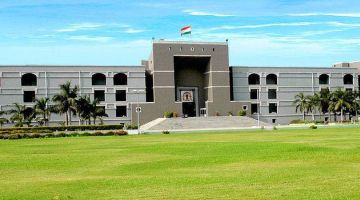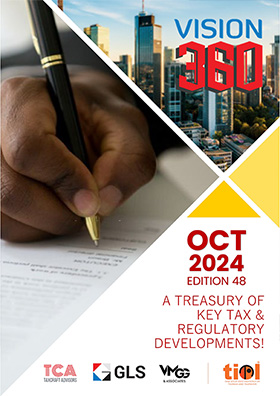CX - Corrigendum is not a piece of legislation, cannot be applied retrospectively: High Court
By TIOL News Service
AHMEDABAD, MAR 07, 2018: FACTS: Finance Bill, 1996 proposed slashing of the rates of Excise duty to 10% basic duty for both kinds of fabrics (whether processed or unprocessed) and to 10% of additional duty for processed fabric; while maintaining Nil rate of additional duty for unprocessed fabric.
However, before the Bill was enacted, a proposal was moved to make amendments in the Bill itself which would ensure that the unprocessed fabric would attract basic duty @ 12% and no additional duty. Whereas, in the case of processed fabric, the basic duty would be increased to 12% from 10% and the additional duty would be reduced from 10% to 8%, thereby still maintaining total collection of duty on processed fabric at the rate of 20% ad valorem.
Such Budget proposals were accepted by the Parliament and the Finance Act, 1996 came to be passed on 28.09.1996.
However, when the draft of the Act was sent for printing, there were certain ‘inadvertent' errors due to which the basic rate of duty prescribed for both processed and unprocessed fabric was printed as 10% ad valorem. It appears that the published rate of additional duty for processed fabric was also 10%.
Realizing that such a printing error had crept-in in the Gazetted Finance Act, a corrigendum came to be issued on 15th January 1997 correcting such printing errors and specifying that the actual basic rate of duty for such fabric would be 12% - whether processed or unprocessed. But here again there was a mistake inasmuch as instead of line 39 which was to be mentioned as being corrected, the line mentioned was line 31! And it was only by virtue of the later corrigendum dated 21st September 2000 that the situation got sufficiently cleared.
On the basis of such publication, the respondent Revenue started issuing show cause notices demanding the differential Central Excise duty.
Petition:
The petitioners have challenged the corrigenda issued by the Government of India dated 15th January 1997 and 21st September 2000 and the SCNs and submit that such corrigendum cannot be applied retrospectively so as to cover clearances of the petitioners which were made long before.
Observations of High Court:
After considering the exhaustive submissions made by both sides and the affidavit filed by the respondent, the High Court inter alia observed thus -
“15. We have no hesitation in accepting these explanations of Union of India. We do not have for a moment any doubt that all along what was presented before the Parliament, after the amendment in the Finance Bill and what was accepted by the Parliament was the prescription of basic rate of duty at 12% for unprocessed as well as processed fabric. The affidavits filed by the responsible officers of the Union of India need not be doubted. We have, therefore, no reason to believe that the budgetary proposals did not carry such amendment or that the Parliament did not accept such proposals; as is stated before us."
The High Court further observed –
“…What has come on record as undisputed, or at any rate indisputable position is that after the Finance Act 1996 was passed, it received assent of the President and thereby became a law, the official publications printed 10% as basic rate of duty for unprocessed as well as processed fabric. In fact, the same error also continued while printing the additional rate of duty for processed fabric at 10% instead of 8%; as per the amendments…"
Coming to the corrigendum dated 15.01.1997, the High Court observed that the same could not be considered as being of any assistance to the respondents because it was made part of an Ordinance called, "The Depositories Related Laws [Amendment] Ordinance, 1997" and was thus aimed at amending various laws principally concerning the Banking Institutions; that at the end of the ordinance, the said corrigendum dated 15th January 1997 was appended; that the corrigendum was published as a part of an ordinance which pertained to completely unrelated subjects and Acts and had nothing to do with the Central Excise Act, or Central Excise [Tariff] Act and which corrigendum had also failed to achieve its desired object.
The High Court added -
+ The corrigendum made many corrections in the published Finance Act, 1996. One of them was, "in page 52, in line 31 for 10% read 12%". It is an admitted position that line 31 had no reference to the rate of duty for fabric in question.
+ Any manufacturer of the product, even if therefor had chanced upon this corrigendum and had a reason to pursue the same, would not be in any manner wiser that the correct rate of duty prescribed by the Parliament under the Finance Act, 1996 for his manufacturing activity was 12% and not 10%.
+ No reasonable person can be expected to inquire further and collect information as to which line this corrigendum refers to, if not line 31 of the document in question. The duty of the manufacturer would be to be reasonably careful, apprise himself of all publications and notifications of the Government of India concerning his product and prescribed rate of duty.
+ Such reasonable duty to take care would not travel beyond as to expect him to extrapolate a corrigendum in the nature of correction by correctly reading the line in the corrigendum as to fit the correct place in the document and then modify and read for himself.
+ What the respondents expected the petitioner and other similarly situated manufacturers to do was to make self correction in the corrigendum dated 15th January 1997 and read the reference to line 31 as the reference to line no. 39.
+ It is impossible to deduce that in the corrigendum dated 15th January 1997, the reference to the rate of duty was with respect to line no. 39 and not 31, as printed. This page contains various entries. These are in the nature of amendments in the Schedule to the Central Excise Tariff Act. Varying rates of duty are prescribed under the new prescriptions. At at least at one more place, the revised rate of duty prescribed under the said Act is 10%. There is no warrant or any indication in the said corrigendum to presume that the reference is only with respect to various fabrics referred to in the concerned para pertains to line no. 39.
As regards the subsequent corrigendum dated 21.09.2000, the High Court observed –
+ However, such corrections made in the year 2000, long after the rate of duty was published by the Government of India in its official publications, which was also carried by several authentic publishers in their Excise Manuals cannot be applied with retrospective effect.
+ By the time this corrigendum was issued, the entire issue had become academic. The dispute survived only till February 1999, but what the Department now wishes to do is to apply such correction made in September 2000 for clearances made by the petitioners between November 1996 to February 1999.
+ If we permit the Department to do so, we would be breaching the basic principle of collection of duty or Cess by the Government at the rate other than the published rates .
+ Publication of the rate of duty has an important purpose of making the manufacturers aware about the prevailing rate of duty which they would be required to deposit and manage their affair accordingly.
+ Main object of such publication being to put the public at large and the affected tax payers/manufacturers, in particular, to notice about such changes through official source.
+ However, the duty in the present case is sought to be collected at rates higher than the published rates by making correction nearly three years after the rates were published and erroneously re-published.
+ Present is the case of series of errors which had every possibility of misguiding the manufacturer into believing that as per the Finance Act, 1996, the rate of duty prescribed is 10%.
+ The contention that corrigendum dated 21st September 2000 must relate back to the original publication of rate of duty and that in any case the Parliament has power to make law with retrospective effect cannot be accepted.
+ The corrigendum is not a piece of legislation. The question of retrospective effect of such correction cannot be equated with exercise of the power of the Parliament to make a law with retrospective effect. If the corrigendum was needed to apprise the public at large about the correct rate of duty, applying it from the original date of prescription of the revised rate of duty would frustrate the purpose.
In fine, the Show Cause Notices were set aside and the Petition was allowed.
(See 2018-TIOL-392-HC-AHM-CX)















